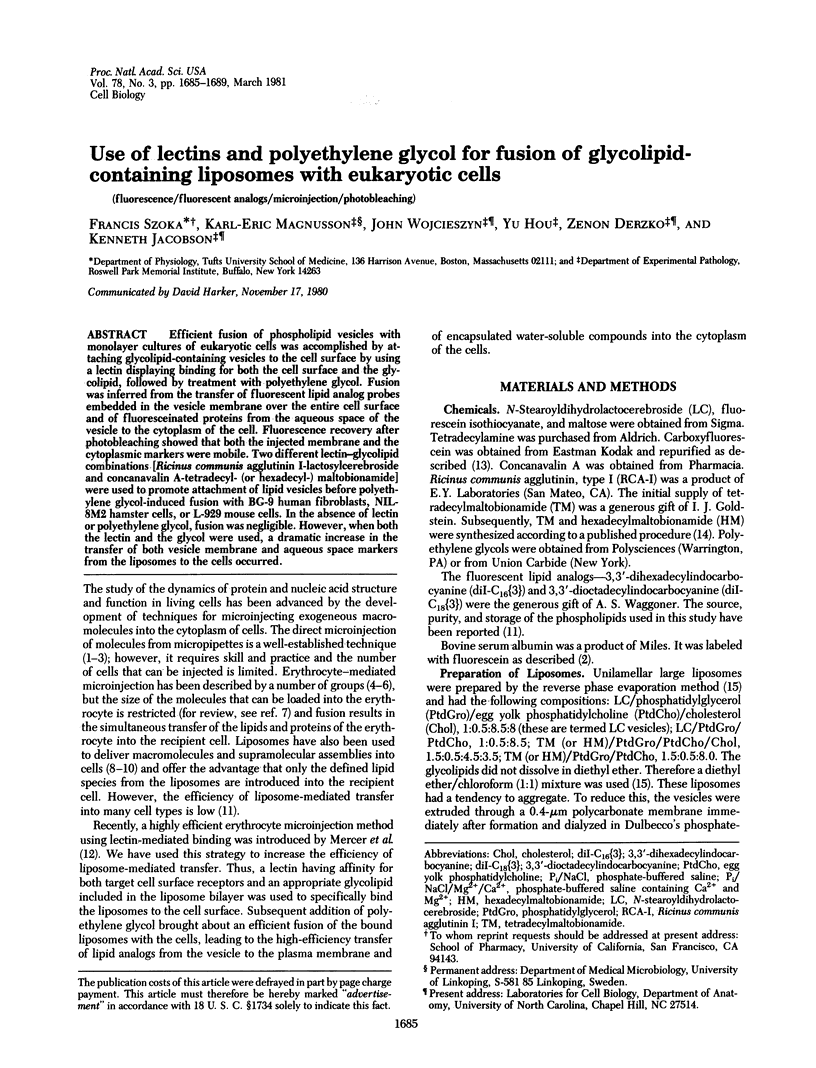Abstract
Efficient fusion of phospholipid vesicles with monolayer cultures of eukaryotic cells was accomplished by attaching glycolipid-containing vesicles to the cell surface by using a lectin displaying binding for both the cell surface and the glycolipid, followed by treatment with polyethylene glycol. Fusion was inferred from the transfer of fluorescent lipid analog probes embedded in the vesicle membrane over the entire cell surface and of fluoresceinated proteins from the aqueous space of the vesicle to the cytoplasm of the cell. Fluorescence recovery after photobleaching showed that both the injected membrane and the cytoplasmic markers were mobile. Two different lectin--glycolipid combinations [Ricinus communis agglutinin I-lactosylcerebroside and concanavalin A-tetradecyl- (or hexadecyl-) maltobionamide] were used to promote attachment of lipid vesicles before polyethylene glycol-induced fusion with BG-9 human fibroblasts, NIL-8M2 hamster cells, or L-929 mouse cells. In the absence of lectin or polyethylene glycol, fusion was negligible. However, when both the lectin and the glycol were used, a dramatic increase in the transfer of both vesicle membrane and aqueous space markers from the liposomes to the cells occurred.
Full text
PDF




Images in this article
Selected References
These references are in PubMed. This may not be the complete list of references from this article.
- Curatolo W., Yau A. O., Small D. M., Sears B. Lectin-induced agglutination of phospholipid/glycolipid vesicles. Biochemistry. 1978 Dec 26;17(26):5740–5744. doi: 10.1021/bi00619a022. [DOI] [PubMed] [Google Scholar]
- Fraley R., Subramani S., Berg P., Papahadjopoulos D. Introduction of liposome-encapsulated SV40 DNA into cells. J Biol Chem. 1980 Nov 10;255(21):10431–10435. [PubMed] [Google Scholar]
- Furusawa M., Nishimura T., Yamaizumi M., Okada Y. Injection of foreign substances into single cells by cell fusion. Nature. 1974 May 31;249(456):449–450. doi: 10.1038/249449a0. [DOI] [PubMed] [Google Scholar]
- Gonzalez-Noriega A., Sly W. S. Concanavalin A mediated uptake of enzymes by fibroblasts. Biochem Biophys Res Commun. 1978 Nov 14;85(1):174–182. doi: 10.1016/s0006-291x(78)80026-6. [DOI] [PubMed] [Google Scholar]
- Graessmann M., Graessman A. "Early" simian-virus-40-specific RNA contains information for tumor antigen formation and chromatin replication. Proc Natl Acad Sci U S A. 1976 Feb;73(2):366–370. doi: 10.1073/pnas.73.2.366. [DOI] [PMC free article] [PubMed] [Google Scholar]
- Jacobson K., Derzko Z., Wu E. S., Hou Y., Poste G. Measurement of the lateral mobility of cell surface components in single, living cells by fluorescence recovery after photobleaching. J Supramol Struct. 1976;5(4):565(417)–576(428). doi: 10.1002/jss.400050411. [DOI] [PubMed] [Google Scholar]
- Juliano R. L., Moore M. R., Callahan J. W., Lowden J. A. Lectin-mediated uptake of lysosomal hydrolases by genetically deficient human fibroblasts. Exp Cell Res. 1979 Apr;120(1):63–72. doi: 10.1016/0014-4827(79)90536-6. [DOI] [PubMed] [Google Scholar]
- Juliano R. L., Stamp D. Lectin-mediated attachment of glycoprotein-bearing liposomes to cells. Nature. 1976 May 20;261(5557):235–238. doi: 10.1038/261235a0. [DOI] [PubMed] [Google Scholar]
- Loyter A., Zakai N., Kulka R. G. "Ultramicroinjection" of macromolecules or small particles into animal cells. A new technique based on virus-induced cell fusion. J Cell Biol. 1975 Aug;66(2):292–304. doi: 10.1083/jcb.66.2.292. [DOI] [PMC free article] [PubMed] [Google Scholar]
- Mercer W. E., Terefinko D. J., Schlegel R. A. Red cell-mediated microinjection of macromolecules into monolayer cultures of mammalian cells. Cell Biol Int Rep. 1979 May;3(3):265–270. doi: 10.1016/0309-1651(79)90039-0. [DOI] [PubMed] [Google Scholar]
- Pagano R. E., Huang L., Wey C. Interaction of phospholipid vesicles with cultured mammalian cells. Nature. 1974 Nov 8;252(5479):166–167. doi: 10.1038/252166a0. [DOI] [PubMed] [Google Scholar]
- Papahadjopoulos D., Poste G., Mayhew E. Cellular uptake of cyclic AMP captured within phospholipid vesicles and effect on cell-growth behaviour. Biochim Biophys Acta. 1974 Sep 23;363(3):404–418. doi: 10.1016/0005-2736(74)90079-0. [DOI] [PubMed] [Google Scholar]
- Redwood W. R., Jansons V. K., Patel B. C. Lectin-receptor interactions in liposomes. Biochim Biophys Acta. 1975 Oct 17;406(3):347–361. doi: 10.1016/0005-2736(75)90015-2. [DOI] [PubMed] [Google Scholar]
- Schlegel R. A., Rechsteiner M. C. Microinjection of thymidine kinase and bovine serum albumin into mammalian cells by fusion with red blood cells. Cell. 1975 Aug;5(4):371–379. doi: 10.1016/0092-8674(75)90056-2. [DOI] [PubMed] [Google Scholar]
- Schlegel R. A., Rechsteiner M. C. Red cell-mediated microinjection of macromolecules into mammalian cells. Methods Cell Biol. 1978;20:341–354. doi: 10.1016/s0091-679x(08)62026-9. [DOI] [PubMed] [Google Scholar]
- Schlessinger J., Axelrod D., Koppel D. E., Webb W. W., Elson E. L. Lateral transport of a lipid probe and labeled proteins on a cell membrane. Science. 1977 Jan 21;195(4275):307–309. doi: 10.1126/science.556653. [DOI] [PubMed] [Google Scholar]
- Schneider H., Lemasters J. J., Höchli M., Hackenbrock C. R. Fusion of liposomes with mitochondrial inner membranes. Proc Natl Acad Sci U S A. 1980 Jan;77(1):442–446. doi: 10.1073/pnas.77.1.442. [DOI] [PMC free article] [PubMed] [Google Scholar]
- Stacey D. W., Allfrey V. G. Evidence for the autophagy of microinjected proteins in HeLA cells. J Cell Biol. 1977 Dec;75(3):807–817. doi: 10.1083/jcb.75.3.807. [DOI] [PMC free article] [PubMed] [Google Scholar]
- Surolia A., Bachhawat B. K., Podder S. K. Interaction between lectin from Ricinus communis and liposomes containing gangliosides. Nature. 1975 Oct 30;257(5529):802–804. doi: 10.1038/257802a0. [DOI] [PubMed] [Google Scholar]
- Szoka F. C., Jr, Jacobson K., Papahadjopoulos D. The use of aqueous space markers to determine the mechanism of interaction between phospholipid vesicles and cells. Biochim Biophys Acta. 1979 Mar 8;551(2):295–303. doi: 10.1016/0005-2736(89)90007-2. [DOI] [PubMed] [Google Scholar]
- Szoka F., Jacobson K., Derzko Z., Papahadjopoulos D. Fluorescence studies on the mechanism of liposome-cell interactions in vitro. Biochim Biophys Acta. 1980 Jul 16;600(1):1–18. doi: 10.1016/0005-2736(80)90406-x. [DOI] [PubMed] [Google Scholar]
- Szoka F., Jr, Papahadjopoulos D. Comparative properties and methods of preparation of lipid vesicles (liposomes). Annu Rev Biophys Bioeng. 1980;9:467–508. doi: 10.1146/annurev.bb.09.060180.002343. [DOI] [PubMed] [Google Scholar]
- Szoka F., Jr, Papahadjopoulos D. Procedure for preparation of liposomes with large internal aqueous space and high capture by reverse-phase evaporation. Proc Natl Acad Sci U S A. 1978 Sep;75(9):4194–4198. doi: 10.1073/pnas.75.9.4194. [DOI] [PMC free article] [PubMed] [Google Scholar]
- Wilson T., Papahadjopoulos D., Taber R. Biological properties of poliovirus encapsulated in lipid vesicles: antibody resistance and infectivity in virus-resistant cells. Proc Natl Acad Sci U S A. 1977 Aug;74(8):3471–3475. doi: 10.1073/pnas.74.8.3471. [DOI] [PMC free article] [PubMed] [Google Scholar]
- van der Bosch J., McConnell M. Fusion of dipalmitoylphosphatidylcholine vesicle membranes induced by concanavalin A. Proc Natl Acad Sci U S A. 1975 Nov;72(11):4409–4413. doi: 10.1073/pnas.72.11.4409. [DOI] [PMC free article] [PubMed] [Google Scholar]







